Abstract
Inherited cardiomyopathies may arise from mutations in genes that are normally expressed in both heart and skeletal muscle and therefore may be accompanied by skeletal muscle weakness. Phenotypically, patients with familial dilated cardiomyopathy (FDC) show enlargement of all four chambers of the heart and develop symptoms of congestive heart failure. Inherited cardiomyopathies may also be accompanied by cardiac conduction-system defects that affect the atrioventricular node, resulting in bradycardia. Several different chromosomal regions have been linked with the development of autosomal dominant FDC, but the gene defects in these disorders remain unknown. We now characterize an autosomal dominant disorder involving dilated cardiomyopathy, cardiac conduction-system disease, and adult-onset limb-girdle muscular dystrophy (FDC, conduction disease, and myopathy [FDC-CDM]). Genetic linkage was used to exclude regions of the genome known to be linked to dilated cardiomyopathy and muscular dystrophy phenotypes and to confirm genetic heterogeneity of these disorders. A genomewide scan identified a region on the long arm of chromosome 6 that is significantly associated with the presence of myopathy (D6S262; maximum LOD score [Z(max)] 4.99 at maximum recombination fraction [theta(max)] .00), identifying FDC-CDM as a genetically distinct disease. Haplotype analysis refined the interval containing the genetic defect, to a 3-cM interval between D6S1705 and D6S1656. This haplotype analysis excludes a number of striated muscle-expressed genes present in this region, including laminin alpha2, laminin alpha4, triadin, and phospholamban.
Full text
PDF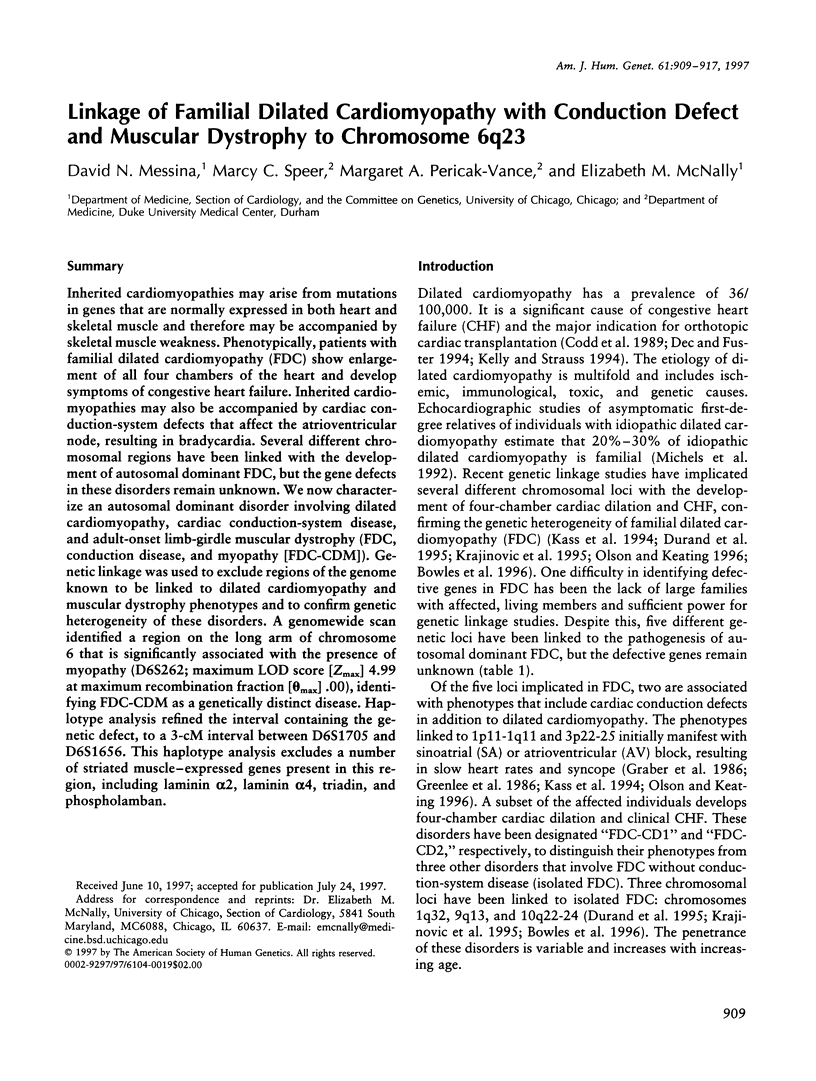
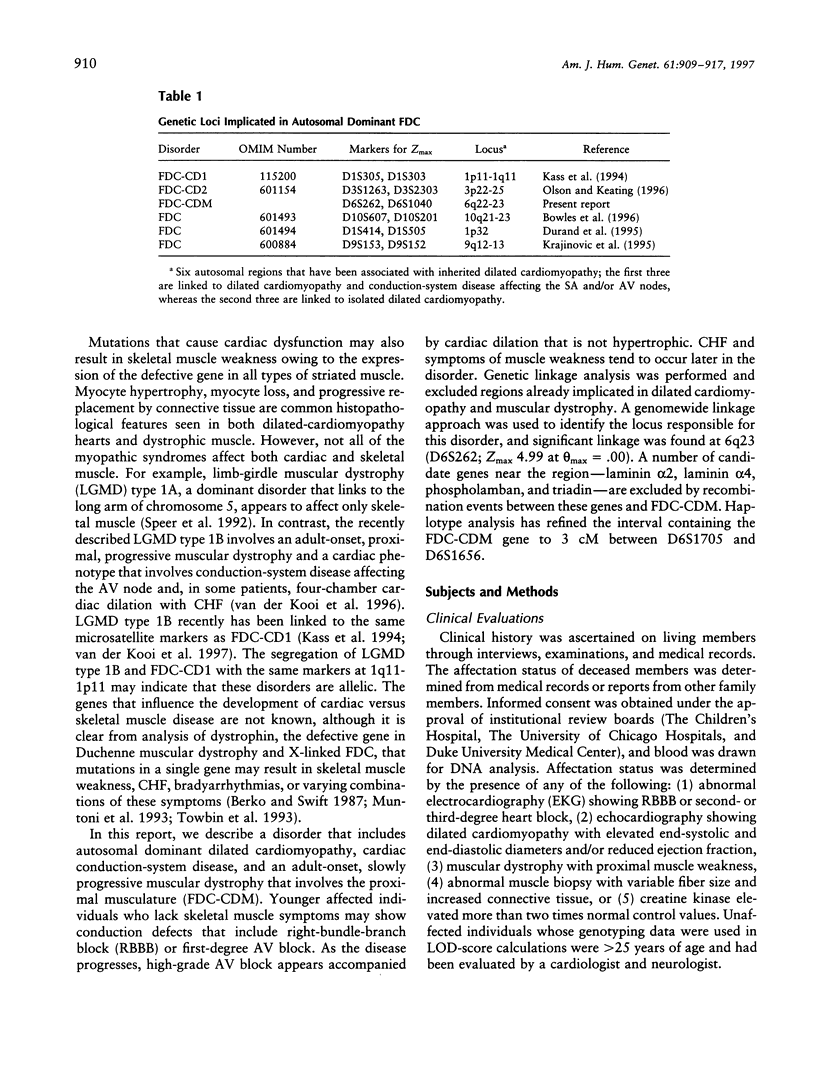
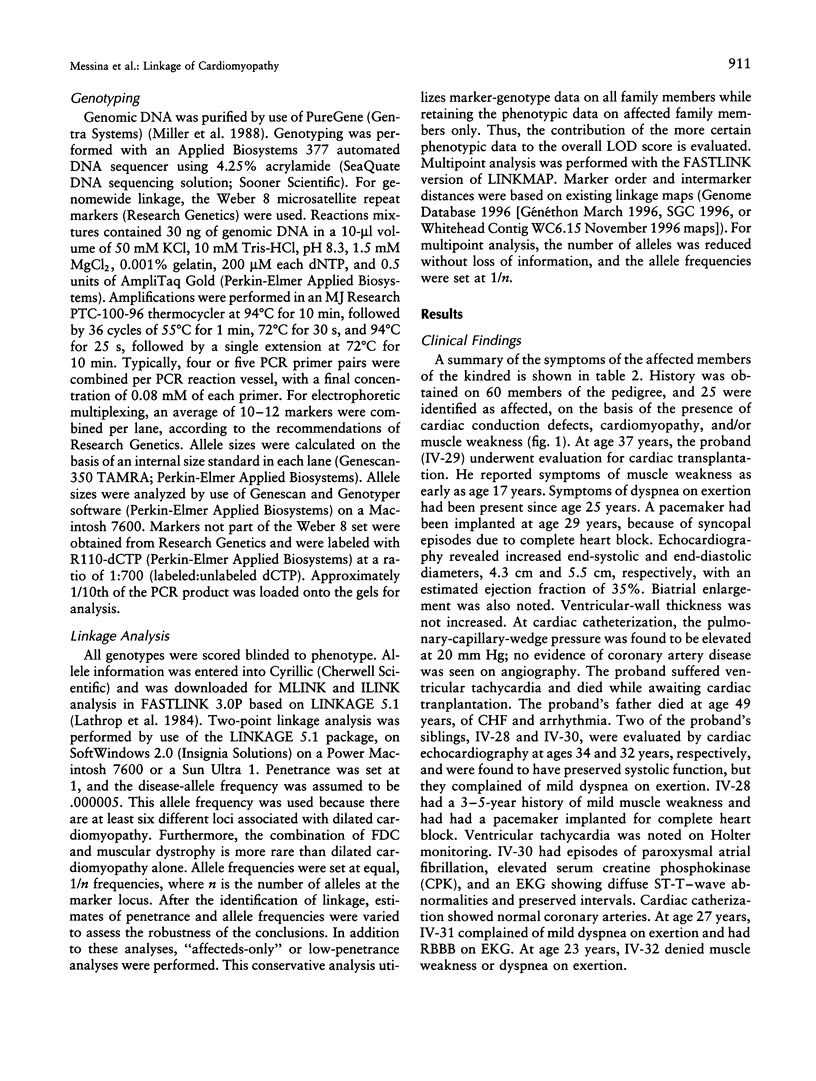
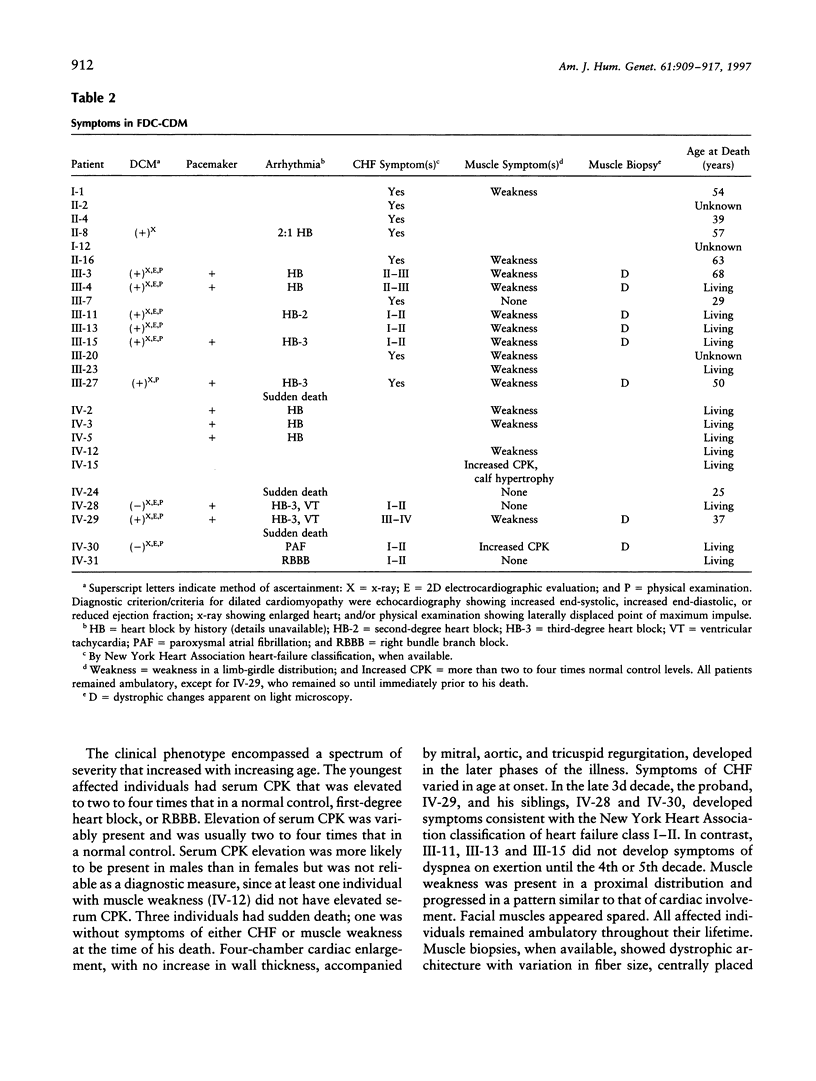

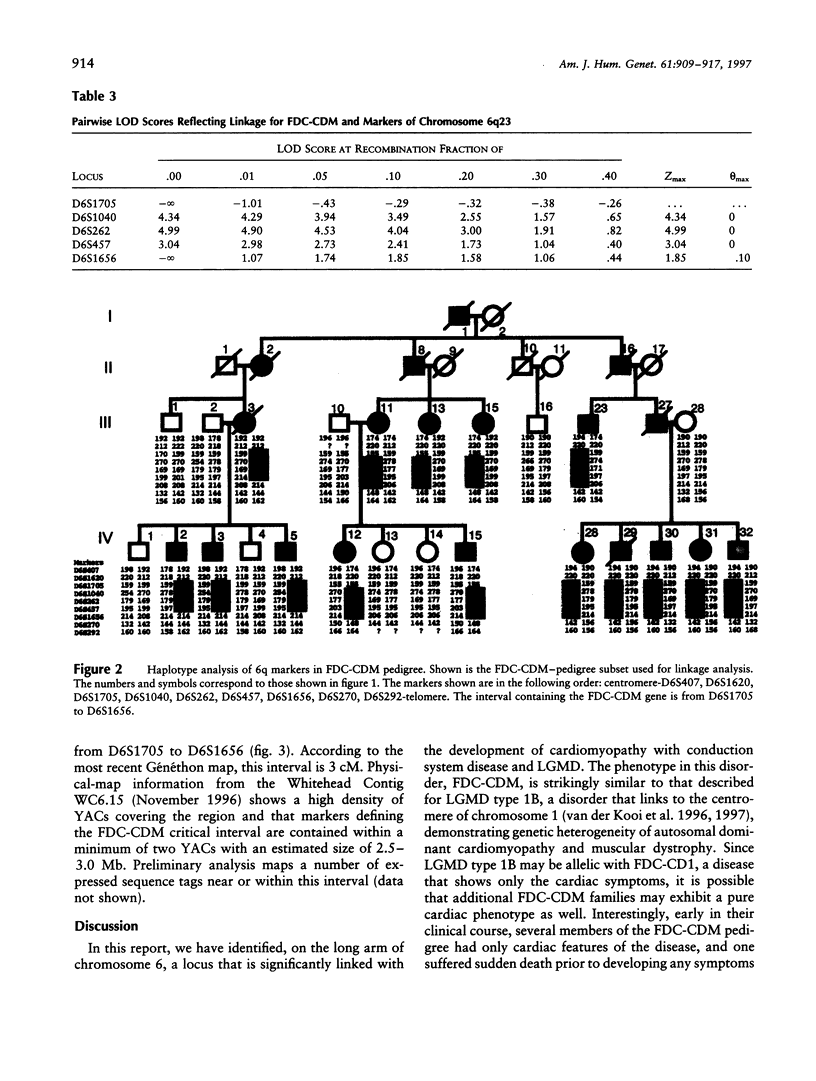

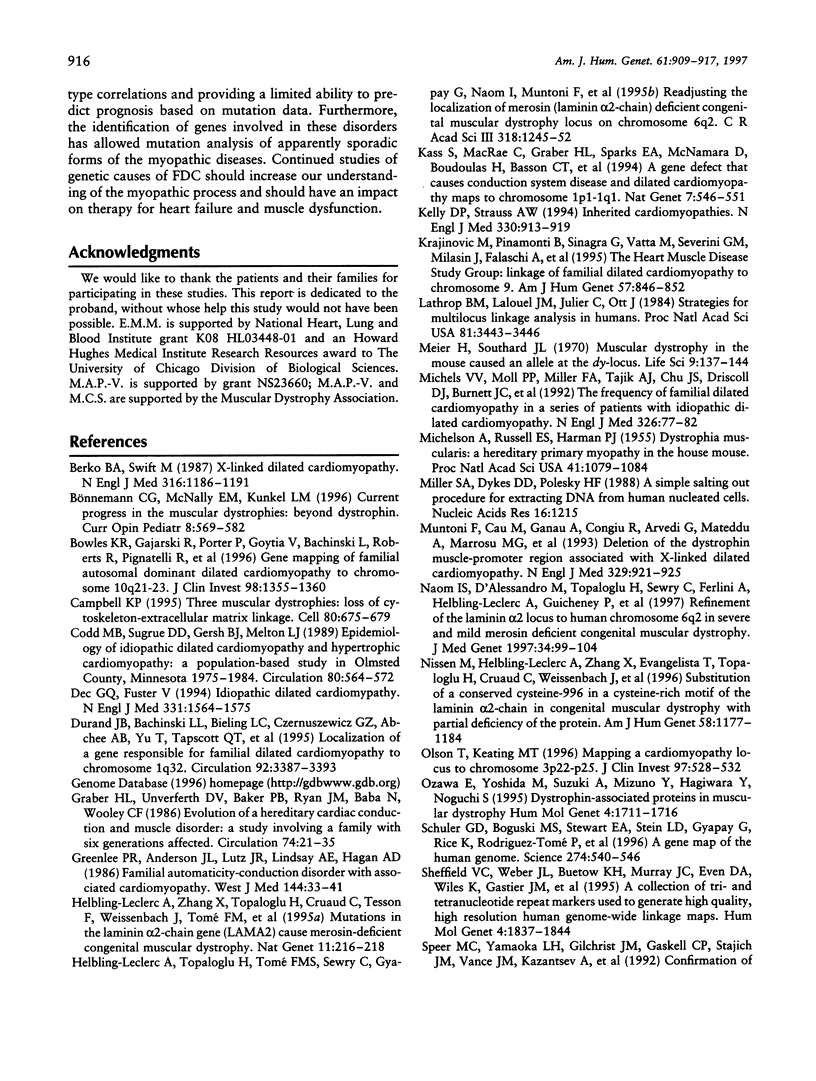

Images in this article
Selected References
These references are in PubMed. This may not be the complete list of references from this article.
- Berko B. A., Swift M. X-linked dilated cardiomyopathy. N Engl J Med. 1987 May 7;316(19):1186–1191. doi: 10.1056/NEJM198705073161904. [DOI] [PubMed] [Google Scholar]
- Bowles K. R., Gajarski R., Porter P., Goytia V., Bachinski L., Roberts R., Pignatelli R., Towbin J. A. Gene mapping of familial autosomal dominant dilated cardiomyopathy to chromosome 10q21-23. J Clin Invest. 1996 Sep 15;98(6):1355–1360. doi: 10.1172/JCI118922. [DOI] [PMC free article] [PubMed] [Google Scholar]
- Bönnemann C. G., McNally E. M., Kunkel L. M. Beyond dystrophin: current progress in the muscular dystrophies. Curr Opin Pediatr. 1996 Dec;8(6):569–582. [PubMed] [Google Scholar]
- Campbell K. P. Three muscular dystrophies: loss of cytoskeleton-extracellular matrix linkage. Cell. 1995 Mar 10;80(5):675–679. doi: 10.1016/0092-8674(95)90344-5. [DOI] [PubMed] [Google Scholar]
- Codd M. B., Sugrue D. D., Gersh B. J., Melton L. J., 3rd Epidemiology of idiopathic dilated and hypertrophic cardiomyopathy. A population-based study in Olmsted County, Minnesota, 1975-1984. Circulation. 1989 Sep;80(3):564–572. doi: 10.1161/01.cir.80.3.564. [DOI] [PubMed] [Google Scholar]
- Dec G. W., Fuster V. Idiopathic dilated cardiomyopathy. N Engl J Med. 1994 Dec 8;331(23):1564–1575. doi: 10.1056/NEJM199412083312307. [DOI] [PubMed] [Google Scholar]
- Durand J. B., Bachinski L. L., Bieling L. C., Czernuszewicz G. Z., Abchee A. B., Yu Q. T., Tapscott T., Hill R., Ifegwu J., Marian A. J. Localization of a gene responsible for familial dilated cardiomyopathy to chromosome 1q32. Circulation. 1995 Dec 15;92(12):3387–3389. doi: 10.1161/01.cir.92.12.3387. [DOI] [PubMed] [Google Scholar]
- Graber H. L., Unverferth D. V., Baker P. B., Ryan J. M., Baba N., Wooley C. F. Evolution of a hereditary cardiac conduction and muscle disorder: a study involving a family with six generations affected. Circulation. 1986 Jul;74(1):21–35. doi: 10.1161/01.cir.74.1.21. [DOI] [PubMed] [Google Scholar]
- Greenlee P. R., Anderson J. L., Lutz J. R., Lindsay A. E., Hagan A. D. Familial automaticity-conduction disorder with associated cardiomyopathy. West J Med. 1986 Jan;144(1):33–41. [PMC free article] [PubMed] [Google Scholar]
- Helbling-Leclerc A., Topaloglu H., Tomé F. M., Sewry C., Gyapay G., Naom I., Muntoni F., Dubowitz V., Barois A., Estournet B. Readjusting the localization of merosin (laminin alpha 2-chain) deficient congenital muscular dystrophy locus on chromosome 6q2. C R Acad Sci III. 1995 Dec;318(12):1245–1252. [PubMed] [Google Scholar]
- Helbling-Leclerc A., Zhang X., Topaloglu H., Cruaud C., Tesson F., Weissenbach J., Tomé F. M., Schwartz K., Fardeau M., Tryggvason K. Mutations in the laminin alpha 2-chain gene (LAMA2) cause merosin-deficient congenital muscular dystrophy. Nat Genet. 1995 Oct;11(2):216–218. doi: 10.1038/ng1095-216. [DOI] [PubMed] [Google Scholar]
- Kass S., MacRae C., Graber H. L., Sparks E. A., McNamara D., Boudoulas H., Basson C. T., Baker P. B., 3rd, Cody R. J., Fishman M. C. A gene defect that causes conduction system disease and dilated cardiomyopathy maps to chromosome 1p1-1q1. Nat Genet. 1994 Aug;7(4):546–551. doi: 10.1038/ng0894-546. [DOI] [PubMed] [Google Scholar]
- Kelly D. P., Strauss A. W. Inherited cardiomyopathies. N Engl J Med. 1994 Mar 31;330(13):913–919. doi: 10.1056/NEJM199403313301308. [DOI] [PubMed] [Google Scholar]
- Krajinovic M., Pinamonti B., Sinagra G., Vatta M., Severini G. M., Milasin J., Falaschi A., Camerini F., Giacca M., Mestroni L. Linkage of familial dilated cardiomyopathy to chromosome 9. Heart Muscle Disease Study Group. Am J Hum Genet. 1995 Oct;57(4):846–852. [PMC free article] [PubMed] [Google Scholar]
- Lathrop G. M., Lalouel J. M., Julier C., Ott J. Strategies for multilocus linkage analysis in humans. Proc Natl Acad Sci U S A. 1984 Jun;81(11):3443–3446. doi: 10.1073/pnas.81.11.3443. [DOI] [PMC free article] [PubMed] [Google Scholar]
- Meier H., Southard J. L. Muscular dystrophy in the mouse caused by an allele at the dy-locus. Life Sci. 1970 Feb 8;9(3):137–144. doi: 10.1016/0024-3205(70)90306-1. [DOI] [PubMed] [Google Scholar]
- Michels V. V., Moll P. P., Miller F. A., Tajik A. J., Chu J. S., Driscoll D. J., Burnett J. C., Rodeheffer R. J., Chesebro J. H., Tazelaar H. D. The frequency of familial dilated cardiomyopathy in a series of patients with idiopathic dilated cardiomyopathy. N Engl J Med. 1992 Jan 9;326(2):77–82. doi: 10.1056/NEJM199201093260201. [DOI] [PubMed] [Google Scholar]
- Michelson A. M., Russell E. S., Harman P. J. Dystrophia Muscularis: A HEREDITARY PRIMARY MYOPATHY IN THE HOUSE MOUSE. Proc Natl Acad Sci U S A. 1955 Dec 15;41(12):1079–1084. doi: 10.1073/pnas.41.12.1079. [DOI] [PMC free article] [PubMed] [Google Scholar]
- Miller S. A., Dykes D. D., Polesky H. F. A simple salting out procedure for extracting DNA from human nucleated cells. Nucleic Acids Res. 1988 Feb 11;16(3):1215–1215. doi: 10.1093/nar/16.3.1215. [DOI] [PMC free article] [PubMed] [Google Scholar]
- Muntoni F., Cau M., Ganau A., Congiu R., Arvedi G., Mateddu A., Marrosu M. G., Cianchetti C., Realdi G., Cao A. Brief report: deletion of the dystrophin muscle-promoter region associated with X-linked dilated cardiomyopathy. N Engl J Med. 1993 Sep 23;329(13):921–925. doi: 10.1056/NEJM199309233291304. [DOI] [PubMed] [Google Scholar]
- Naom I. S., D'Alessandro M., Topaloglu H., Sewry C., Ferlini A., Helbling-Leclerc A., Guicheney P., Weissenbach J., Schwartz K., Bushby K. Refinement of the laminin alpha2 chain locus to human chromosome 6q2 in severe and mild merosin deficient congenital muscular dystrophy. J Med Genet. 1997 Feb;34(2):99–104. doi: 10.1136/jmg.34.2.99. [DOI] [PMC free article] [PubMed] [Google Scholar]
- Nissinen M., Helbling-Leclerc A., Zhang X., Evangelista T., Topaloglu H., Cruaud C., Weissenbach J., Fardeau M., Tomé F. M., Schwartz K. Substitution of a conserved cysteine-996 in a cysteine-rich motif of the laminin alpha2-chain in congenital muscular dystrophy with partial deficiency of the protein. Am J Hum Genet. 1996 Jun;58(6):1177–1184. [PMC free article] [PubMed] [Google Scholar]
- Olson T. M., Keating M. T. Mapping a cardiomyopathy locus to chromosome 3p22-p25. J Clin Invest. 1996 Jan 15;97(2):528–532. doi: 10.1172/JCI118445. [DOI] [PMC free article] [PubMed] [Google Scholar]
- Ozawa E., Yoshida M., Suzuki A., Mizuno Y., Hagiwara Y., Noguchi S. Dystrophin-associated proteins in muscular dystrophy. Hum Mol Genet. 1995;4(Spec No):1711–1716. doi: 10.1093/hmg/4.suppl_1.1711. [DOI] [PubMed] [Google Scholar]
- Schuler G. D., Boguski M. S., Stewart E. A., Stein L. D., Gyapay G., Rice K., White R. E., Rodriguez-Tomé P., Aggarwal A., Bajorek E. A gene map of the human genome. Science. 1996 Oct 25;274(5287):540–546. [PubMed] [Google Scholar]
- Sheffield V. C., Weber J. L., Buetow K. H., Murray J. C., Even D. A., Wiles K., Gastier J. M., Pulido J. C., Yandava C., Sunden S. L. A collection of tri- and tetranucleotide repeat markers used to generate high quality, high resolution human genome-wide linkage maps. Hum Mol Genet. 1995 Oct;4(10):1837–1844. doi: 10.1093/hmg/4.10.1837. [DOI] [PubMed] [Google Scholar]
- Speer M. C., Yamaoka L. H., Gilchrist J. H., Gaskell C. P., Stajich J. M., Vance J. M., Kazantsev A., Lastra A. A., Haynes C. S., Beckmann J. S. Confirmation of genetic heterogeneity in limb-girdle muscular dystrophy: linkage of an autosomal dominant form to chromosome 5q. Am J Hum Genet. 1992 Jun;50(6):1211–1217. [PMC free article] [PubMed] [Google Scholar]
- Towbin J. A., Hejtmancik J. F., Brink P., Gelb B., Zhu X. M., Chamberlain J. S., McCabe E. R., Swift M. X-linked dilated cardiomyopathy. Molecular genetic evidence of linkage to the Duchenne muscular dystrophy (dystrophin) gene at the Xp21 locus. Circulation. 1993 Jun;87(6):1854–1865. doi: 10.1161/01.cir.87.6.1854. [DOI] [PubMed] [Google Scholar]
- Vainzof M., Marie S. K., Reed U. C., Schwartzman J. S., Pavanello R. C., Passos-Bueno M. R., Zatz M. Deficiency of merosin (laminin M or alpha 2) in congenital muscular dystrophy associated with cerebral white matter alterations. Neuropediatrics. 1995 Dec;26(6):293–297. doi: 10.1055/s-2007-979777. [DOI] [PubMed] [Google Scholar]
- Watkins H., Seidman J. G., Seidman C. E. Familial hypertrophic cardiomyopathy: a genetic model of cardiac hypertrophy. Hum Mol Genet. 1995;4(Spec No):1721–1727. doi: 10.1093/hmg/4.suppl_1.1721. [DOI] [PubMed] [Google Scholar]
- Wewer U. M., Engvall E. Merosin/laminin-2 and muscular dystrophy. Neuromuscul Disord. 1996 Dec;6(6):409–418. doi: 10.1016/s0960-8966(96)00384-7. [DOI] [PubMed] [Google Scholar]
- van der Kooi A. J., Ledderhof T. M., de Voogt W. G., Res C. J., Bouwsma G., Troost D., Busch H. F., Becker A. E., de Visser M. A newly recognized autosomal dominant limb girdle muscular dystrophy with cardiac involvement. Ann Neurol. 1996 May;39(5):636–642. doi: 10.1002/ana.410390513. [DOI] [PubMed] [Google Scholar]
- van der Kooi A. J., van Meegen M., Ledderhof T. M., McNally E. M., de Visser M., Bolhuis P. A. Genetic localization of a newly recognized autosomal dominant limb-girdle muscular dystrophy with cardiac involvement (LGMD1B) to chromosome 1q11-21. Am J Hum Genet. 1997 Apr;60(4):891–895. [PMC free article] [PubMed] [Google Scholar]



